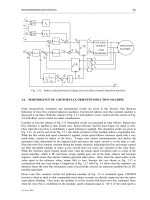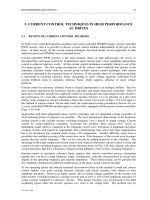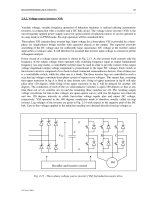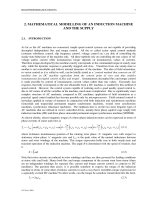High performance embedded computing by wayne wolf
Bạn đang xem bản rút gọn của tài liệu. Xem và tải ngay bản đầy đủ của tài liệu tại đây (14.69 MB, 542 trang )
WolfFront.fm Page i Wednesday, August 9, 2006 1:21 PM
In Praise of High-Performance Embedded Computing:
Architectures, Applications, and Methodologies
High-Performance Embedded Computing is a timely addition to the literature of system
design. The number of designs, as well as the number of installed embedded systems,
vastly surpasses those of general purpose computing, yet there are very few books on
embedded design. This book introduces a comprehensive set of topics ranging from
design methodologies to metrics to optimization techniques for the critical embedded
system resources of space, time, and energy. There is substantial coverage of the increasingly important design issues associated with multiprocessor systems. Wayne Wolf is a
leading expert in embedded design. He has personally conducted research on many of
the topics presented in the book, as well as practiced the design methodologies on the
numerous embedded systems he has built. This book contains information valuable to
the embedded system veteran as well as the novice designer.
—Daniel P. Siewiorek, Carnegie Mellon University
High-Performance Embedded Computing addresses high-end embedded computers—
certainly an area where a skilled balance between hardware and software competencies
is particularly important for practitioners, and arguably a research domain which will be
at the heart of the most interesting methodological evolutions in the coming years.
Focusing on best industrial practices and real-world examples and applications, Wayne
Wolf presents in an organized and integrated way an impressive amount of leading-edge
research approaches, many of which will most likely become key differentiators for winning designs in the coming decade. This is a timely book ideally suited both for practitioners and students in advanced embedded computer engineering courses, as well as
researchers and scientists who want to get a snapshot of the important research taking
place at the confluence of computer architecture and electronic design automation.
—Paolo Ienne, Ecole Polytechnique Fédérale de Lausanne (EPFL),
Lausanne, Switzerland
As processors continue to leap off our desks and embed themselves into our appliances,
our cars, our phones, and perhaps soon our clothing and our wallets, it’s become clear
that embedded computing is no longer a slow, boring sideshow in the architecture circus.
It’s moved to the center ring. Wayne Wolf’s book pulls all the diverse hardware and software threads together into one solid text for the aspiring embedded systems builder.
—Rob A. Rutenbar, Carnegie Mellon University
Educators in all areas of computer systems and engineering should take a look at this
book. Its contrasting perspective on performance, architecture, and design offer an
enhanced comprehension of underlying concepts to students at all levels. In my opinion,
it represents the shape of things to come for anyone seeking a career in “systems.”
—Steven Johnson, Indiana University
WolfFront.fm Page ii Wednesday, August 9, 2006 1:21 PM
More and more embedded devices are available, as people now walk around with cell
phones, PDAs, and MP3 players at their side. The design and constraints of these devices
are much different than those of a generic computing system, such as a laptop or desktop
PC. High-Performance Embedded Computing provides an abundance of information on
these basic design topics while also covering newer areas of research, such as sensor networks and multiprocessors.
—Mitchell D. Theys, University of Illinois at Chicago
High-Performance Embedded Computing not only presents the state of the art in embedded computing augmented with a discussion of relevant example systems, it also features
topics such as software/hardware co-design and multiprocessor architectures for embedded computing. This outstanding book is valuable reading for researchers, practitioners,
and students.
—Andreas Polze, Hasso-Plattner-Institute, Universität Potsdam
Embedded computer systems are everywhere. This state-of-the-art book brings together
industry practices and the latest research in this arena. It provides an in-depth and comprehensive treatment of the fundamentals, advanced topics, contemporary issues, and
real-world challenges in the design of high-performance embedded systems. HighPerformance Embedded Computing will be extremely valuable to graduate students,
researchers, and practicing professionals.
—Jie Hu, New Jersey Institute of Technology
WolfFront.fm Page iii Wednesday, August 9, 2006 1:21 PM
High-Performance Embedded
Computing
WolfFront.fm Page iv Wednesday, August 9, 2006 1:21 PM
About the Author
Wayne Wolf is a professor of electrical engineering and associated faculty in
computer science at Princeton University. Before joining Princeton, he was with
AT&T Bell Laboratories in Murray Hill, New Jersey. He received his B.S., M.S.,
and Ph.D. in electrical engineering from Stanford University. He is well known
for his research in the areas of hardware/software co-design, embedded computing, VLSI, and multimedia computing systems. He is a fellow of the IEEE and
ACM and a member of the SPIE. He won the ASEE Frederick E. Terman Award
in 2003. He was program chair of the First International Workshop on Hardware/Software Co-Design. Wayne was also program chair of the 1996 IEEE
International Conference on Computer Design, the 2002 IEEE International
Conference on Compilers, Architecture, and Synthesis for Embedded Systems,
and the 2005 ACM EMSOFT Conference. He was on the first executive committee of the ACM Special Interest Group on Embedded Computing (SIGBED).
He is the founding editor-in-chief of ACM Transactions on Embedded Computing Systems. He was editor-in-chief of IEEE Transactions on VLSI Systems
(1999–2000) and was founding co-editor of the Kluwer journal Design Automation for Embedded Systems. He is also series editor of the Morgan Kaufmann
Series in Systems on Silicon.
WolfFront.fm Page v Wednesday, August 9, 2006 1:21 PM
High-Performance Embedded
Computing
Architectures, Applications, and
Methodologies
Wayne Wolf
Princeton University
AMSTERDAM • BOSTON • HEIDELBERG • LONDON
NEW YORK • OXFORD • PARIS • SAN DIEGO
SAN FRANCISCO • SINGAPORE • SYDNEY • TOKYO
MORGAN KAUFMANN PUBLISHERS IS AN IMPRINT OF ELSEVIER
WolfFront.fm Page vi Wednesday, August 9, 2006 1:21 PM
Publisher
Publishing Services Mgr.
Developmental Editor
Editorial Assistant
Cover Design
Cover Image
Text Design
Composition
Technical Illustration
Proofreader
Indexer
Printer
Denise E. M. Penrose
George Morrison
Nate McFadden
Kimberlee Honjo
Dick Hanus
Corbus Design
Rebecca Evans & Associates
Multiscience Press, Inc.
diacriTech
Jodie Allen
Steve Rath
Maple-Vail Book Manufacturing Group
Morgan Kaufmann Publishers is an imprint of Elsevier.
500 Sansome Street, Suite 400, San Francisco, CA 94111
This book is printed on acid-free paper.
© 2007 by Elsevier Inc. All rights reserved.
Designations used by companies to distinguish their products are often claimed as trademarks or registered trademarks. In
all instances in which Morgan Kaufmann Publishers is aware of a claim, the product names appear in initial capital or all
capital letters. Readers, however, should contact the appropriate companies for more complete information regarding
trademarks and registration.
No part of this publication may be reproduced, stored in a retrieval system, or transmitted in any form or by any means—
electronic, mechanical, photocopying, scanning, or otherwise—without prior written permission of the publisher.
Permissions may be sought directly from Elsevier’s Science & Technology Rights Department in Oxford, UK: phone:
(+44) 1865 843830, fax: (+44) 1865 853333, e-mail: You may also complete your request online via the Elsevier homepage () by selecting “Customer Support” and then “Obtaining Permissions.”
Library of Congress Cataloging-in-Publication Data
Application submitted.
ISBN 13: 978-0-12-369485-0
ISBN 10: 0-12-369485-X
For information on all Morgan Kaufmann publications,
visit our Web site at www.mkp.com or www.books.elsevier.com
Printed in the United States of America
06 07 08 09 10
5 4 3 2 1
WolfFront.fm Page vii Wednesday, August 9, 2006 1:21 PM
To Nancy and Alec
WolfFront.fm Page viii Wednesday, August 9, 2006 1:21 PM
Supplemental Materials
Resources for this book are available at textbooks.elsevier.com/012369485X.
The instructor site, which is accessible to adopters who register at
textbooks.elsevier.com, includes:
■
Instructor slides (in .ppt format)
■
Figures from the text (in .jpg and .ppt formats)
■
Solutions to exercises (in .pdf format)
The companion site (accessible to all readers) features:
■
Links to related resources on the Web
■
A list of errata
Wolf.book Page ix Tuesday, August 8, 2006 1:56 PM
Contents
Preface
Chapter 1
xvii
Embedded Computing
1
1.1
The Landscape of High-Performance Embedded Computing
1
1.2
Example Applications
1.2.1 Radio and Networking
1.2.2 Multimedia
1.2.3 Vehicle Control and Operation
1.2.4 Sensor Networks
5
5
11
15
18
1.3
Design Goals
21
1.4
Design Methodologies
1.4.1 Basic Design Methodologies
1.4.2 Embedded Systems Design Flows
1.4.3 Standards-Based Design Methodologies
1.4.4 Design Verification and Validation
1.4.5 A Methodology of Methodologies
1.4.6 Joint Algorithm and Architecture Development
22
24
26
28
31
31
32
1.5
Models of Computation
1.5.1 Why Study Models of Computation?
1.5.2 Finite versus Infinite State
1.5.3 Control Flow and Data Flow Models
33
33
34
38
ix
Wolf.book Page x Tuesday, August 8, 2006 1:56 PM
x
Contents
1.5.4 Parallelism and Communication
1.5.5 Sources and Uses of Parallelism
41
45
1.6
Reliability, Safety, and Security
1.6.1 Why Reliable Embedded Systems Are Needed?
1.6.2 Fundamentals of Reliable System Design
1.6.3 Novel Attacks and Countermeasures
46
47
48
52
1.7
Consumer Electronics Architectures
1.7.1 Bluetooth
1.7.2 WiFi
1.7.3 Networked Consumer Devices
1.7.4 High-Level Services
54
54
56
56
58
1.8
Summary and a Look Ahead
60
What We Have Learned
61
Further Reading
61
Questions
61
Lab Exercises
63
CPUs
65
2.1
Introduction
65
2.2
Comparing Processors
2.2.1 Evaluating Processors
2.2.2 A Taxonomy of Processors
2.2.3 Embedded versus General-Purpose Processors
66
66
67
69
2.3
RISC Processors and Digital Signal Processors
2.3.1 RISC Processors
2.3.2 Digital Signal Processors
69
70
71
2.4
Parallel Execution Mechanisms
2.4.1 Very Long Instruction Word Processors
2.4.2 Superscalar Processors
2.4.3 SIMD and Vector Processors
2.4.4 Thread-Level Parallelism
2.4.5 Processor Resource Utilization
77
77
80
80
82
83
Chapter 2
Wolf.book Page xi Tuesday, August 8, 2006 1:56 PM
Contents
xi
2.5
Variable-Performance CPU Architectures
2.5.1 Dynamic Voltage and Frequency Scaling
2.5.2 Better-Than-Worst-Case Design
86
86
88
2.6
Processor Memory Hierarchy
2.6.1 Memory Component Models
2.6.2 Register Files
2.6.3 Caches
2.6.4 Scratch Pad Memories
89
89
95
95
98
2.7
Additional CPU Mechanisms
2.7.1 Code Compression
2.7.2 Code and Data Compression
2.7.3 Low-Power Bus Encoding
2.7.4 Security
99
100
116
117
122
2.8
CPU Simulation
2.8.1 Trace-Based Analysis
2.8.2 Direct Execution
2.8.3 Microarchitecture-Modeling Simulators
126
129
130
131
2.9
Automated CPU Design
2.9.1 Configurable Processors
2.9.2 Instruction Set Synthesis
132
134
143
Summary
150
What We Have Learned
150
Further Reading
151
Questions
151
Lab Exercises
152
Programs
155
3.1
Introduction
155
3.2
Code Generation and Back-End Compilation
3.2.1 Models for Instructions
3.2.2 Register Allocation
3.2.3 Instruction Selection and Scheduling
156
157
160
163
2.10
Chapter 3
Wolf.book Page xii Tuesday, August 8, 2006 1:56 PM
xii
Contents
3.2.4 Code Placement
3.2.5 Programming Environments
167
169
3.3
Memory-Oriented Optimizations
3.3.1 Loop Transformations
3.3.2 Global Optimizations
3.3.3 Buffer, Data Transfer, and Storage Management
3.3.4 Cache- and Scratch Pad–Oriented Optimizations
3.3.5 Main Memory-Oriented Optimizations
170
171
174
176
178
182
3.4
Program Performance Analysis
3.4.1 Performance Models
3.4.2 Path Analysis
3.4.3 Path Timing
185
187
188
190
3.5
Models of Computation and Programming
3.5.1 Interrupt-Oriented Languages
3.5.2 Data Flow Languages
3.5.3 Control-Oriented Languages
3.5.4 Java
3.5.5 Heterogeneous Models of Computation
197
199
200
207
211
214
3.6
Summary
218
What We Have Learned
219
Further Reading
219
Questions
219
Lab Exercises
221
Processes and Operating Systems
223
4.1
Introduction
223
4.2
Real-Time Process Scheduling
4.2.1 Preliminaries
4.2.2 Real-Time Scheduling Algorithms
4.2.3 Scheduling for Dynamic Voltage Scaling
4.2.4 Performance Estimation
224
224
227
234
239
4.3
Languages and Scheduling
241
Chapter 4
Wolf.book Page xiii Tuesday, August 8, 2006 1:56 PM
Contents
xiii
4.4
Operating System Design
4.4.1 Memory Management in Embedded Operating Systems
4.4.2 Structure of a Real-Time Operating System
4.4.3 Operating System Overhead
4.4.4 Support for Scheduling
4.4.5 Interprocess Communication Mechanisms
4.4.6 Power Management
4.4.7 File Systems in Embedded Devices
247
248
250
251
253
254
255
255
4.5
Verification
259
4.6
Summary
264
What We Have Learned
264
Further Reading
264
Questions
264
Lab Exercises
265
Multiprocessor Architectures
267
5.1
Introduction
267
5.2
Why Embedded Multiprocessors?
5.2.1 Requirements on Embedded Systems
5.2.2 Performance and Energy
5.2.3 Specialization and Multiprocessors
5.2.4 Flexibility and Efficiency
269
270
272
274
275
5.3
Multiprocessor Design Techniques
5.3.1 Multiprocessor Design Methodologies
5.3.2 Multiprocessor Modeling and Simulation
275
276
277
5.4
Multiprocessor Architectures
279
5.5
Processing Elements
288
5.6
Interconnection Networks
5.6.1 Models
5.6.2 Network Topologies
5.6.3 Routing and Flow Control
5.6.4 Networks-on-Chips
289
290
292
296
296
Chapter 5
Wolf.book Page xiv Tuesday, August 8, 2006 1:56 PM
xiv
Contents
5.7
Memory Systems
5.7.1 Traditional Parallel Memory Systems
5.7.2 Models for Memory
5.7.3 Heterogeneous Memory Systems
5.7.4 Consistent Parallel Memory Systems
304
304
306
307
309
5.8
Physically Distributed Systems and Networks
5.8.1 Time-Triggered Architecture
5.8.2 FlexRay
5.8.3 Aircraft Networks
312
313
316
324
5.9
Multiprocessor Design Methodologies and Algorithms
326
Summary
332
What We Have Learned
332
Further Reading
333
Questions
333
Lab Exercises
334
Multiprocessor Software
337
6.1
Introduction
337
6.2
What Is Different about Embedded Multiprocessor Software? 337
6.3
Real-Time Multiprocessor Operating Systems
6.3.1 Role of the Operating System
6.3.2 Multiprocessor Scheduling
6.3.3 Scheduling with Dynamic Tasks
339
339
342
359
6.4
Services and Middleware for Embedded Multiprocessors
6.4.1 Standards-Based Services
6.4.2 System-on-Chip Services
6.4.3 Quality-of-Service
361
363
366
370
6.5
Design Verification
376
6.6
Summary
378
What We Have Learned
378
Further Reading
379
5.10
Chapter 6
Wolf.book Page xv Tuesday, August 8, 2006 1:56 PM
Contents
xv
Questions
379
Lab Exercises
381
Hardware and Software Co-design
383
7.1
Introduction
383
7.2
Design Platforms
384
7.3
Performance Analysis
7.3.1 High-Level Synthesis
7.3.2 Accelerator Estimation
387
387
393
7.4
Hardware/Software Co-synthesis Algorithms
7.4.1 Program Representations
7.4.2 Platform Representations
7.4.3 Template-Driven Synthesis Algorithms
7.4.4 Co-synthesis of General Multiprocessors
7.4.5 Multi-objective Optimization
7.4.6 Control and I/O Synthesis
7.4.7 Memory Systems
7.4.8 Co-synthesis for Reconfigurable Systems
396
397
398
400
407
416
421
422
425
7.5
Hardware/Software Co-simulation
428
7.6
Summary
430
What We Have Learned
430
Further Reading
430
Questions
431
Lab Exercises
432
Glossary
433
References
467
Index
501
Chapter 7
Wolf.book Page xvi Tuesday, August 8, 2006 1:56 PM
Wolf.book Page xvii Tuesday, August 8, 2006 1:56 PM
Preface
This book’s goal is to provide a frame of reference for the burgeoning field of
high-performance embedded computing. Computers have moved well beyond
the early days of 8-bit microcontrollers. Today, embedded computers are organized into multiprocessors that can run millions of lines of code. They do so in
real time and at very low power levels. To properly design such systems, a large
and growing body of research has developed to answer questions about the characteristics of embedded hardware and software. These are real systems—aircraft, cell phones, and digital television—that all rely on high-performance
embedded systems. We understand quite a bit about how to design such systems,
but we also have a great deal more to learn.
Real-time control was actually one of the first uses of computers—Chapter 1
mentions the MIT Whirlwind computer, which was developed during the 1950s
for weapons control. But the microprocessor moved embedded computing to the
front burner as an application area for computers. Although sophisticated
embedded systems were in use by 1980, embedded computing as an academic
field did not emerge until the 1990s. Even today, many traditional computer science and engineering disciplines study embedded computing topics without
being fully aware of related work being done in other disciplines.
Embedded computers are very widely used, with billions sold every year. A
huge number of practitioners design embedded systems, and at least a half million programmers work on designs for embedded software. Although embedded
systems vary widely in their details, there are common principles that apply to
the field of embedded computing. Some principles were discovered decades ago
while others are just being developed today. The development of embedded
computing as a research field has helped to move embedded system design from
xvii
Wolf.book Page xviii Tuesday, August 8, 2006 1:56 PM
xviii
Preface
a craft to a discipline, a move that is entirely appropriate given the important,
sometimes safety-critical, tasks entrusted to embedded computers.
One reasonable question to ask about this field is how it differs from traditional computer systems topics, such as client-server systems or scientific computing. Are we just applying the same principles to smaller systems, or do we
need to do something new? I believe that embedded computing, though it makes
use of many techniques from computer science and engineering, poses some
unique challenges.
First, most if not all embedded systems must perform tasks in real time. This
requires a major shift in thinking for both software and hardware designers. Second, embedded computing puts a great deal of emphasis on power and energy
consumption. While power is important in all aspects of computer systems,
embedded applications tend to be closer to the edge of the energy-operation
envelope than many general-purpose systems. All this leads to embedded systems being more heavily engineered to meet a particular set of requirements
than those systems that are designed for general use.
This book assumes that you, the reader, are familiar with the basics of
embedded hardware and software, such as might be found in Computers as
Components. This book builds on those foundations to study a range of
advanced topics. In selecting topics to cover, I tried to identify topics and results
that are unique to embedded computing. I did include some background material
from other disciplines to help set the stage for a discussion of embedded systems
problems.
Here is a brief tour through the book:
■
Chapter 1 provides some important background for the rest of the chapters.
It tries to define the set of topics that are at the center of embedded computing. It looks at methodologies and design goals. We survey models of computation, which serve as a frame of reference for the characteristics of
applications. The chapter also surveys several important applications that
rely on embedded computing to provide background for some terminology
that is used throughout the book.
■
Chapter 2 looks at several different styles of processors that are used in
embedded systems. We consider techniques for tuning the performance of a
processor, such as voltage scaling, and the role of the processor memory
hierarchy in embedded CPUs. We look at techniques used to optimize
embedded CPUs, such as code compression and bus encoding, and techniques for simulating processors.
■
Chapter 3 studies programs. The back end of the compilation process,
which helps determine the quality of the code, is the first topic. We spend a
great deal of time on memory system optimizations, since memory behavior
is a prime determinant of both performance and energy consumption. We
consider performance analysis, including both simulation and worst-case
Wolf.book Page xix Tuesday, August 8, 2006 1:56 PM
Preface xix
execution time analysis. We also discuss how models of computing are
reflected in programming models and languages.
■
Chapter 4 moves up to multiple-process systems. We study and compare
scheduling algorithms, including the interaction between language design
and scheduling mechanisms. We evaluate operating system architectures and
the overhead incurred by the operating system. We also consider methods for
verifying the behavior of multiple process systems.
■
Chapter 5 concentrates on multiprocessor architectures. We consider both
tightly coupled multiprocessors and the physically distributed systems used in
vehicles. We describe architectures and their components: processors, memory, and networks. We also look at methodologies for multiprocessor design.
■
Chapter 6 looks at software for multiprocessors and considers scheduling
algorithms for them. We also study middleware architectures for dynamic
resource allocation in multiprocessors.
■
Chapter 7 concentrates on hardware and software co-design. We study different models that have been used to characterize embedded applications and
target architectures. We cover a wide range of algorithms for co-synthesis
and compare the models and assumptions used by these algorithms.
Hopefully this book covers at least most of the topics of interest to a practitioner and student of advanced embedded computing systems. There were
some topics for which I could find surprisingly little work in the literature: software testing for embedded systems is a prime example. I tried to find representative articles about the major approaches to each problem. I am sure that I have
failed in many cases to adequately represent a particular problem, for which I
apologize.
This book is about embedded computing; it touches on, but does not exhaustively cover, several related fields:
■
Applications—Embedded systems are designed to support applications such
as multimedia, communications, and so on. Chapter 1 introduces some basic
concepts about a few applications, because knowing something about the
application domain is important. An in-depth look at these fields is best left
to others.
■
VLSI—Although systems-on-chips are an important medium for embedded
systems, they are not the only medium. Automobiles, airplanes, and many
other important systems are controlled by distributed embedded networks.
■
Hybrid systems—The field of hybrid systems studies the interactions
between continuous and discrete systems. This is an important and interesting area, and many embedded systems can make use of hybrid system techniques, but hybrid systems deserve their own book.
Wolf.book Page xx Tuesday, August 8, 2006 1:56 PM
xx
Preface
■
Software engineering—Software design is a rich field that provides critical
foundations, but it leaves many questions specific to embedded computing
unanswered.
I would like to thank a number of people who have helped me with this book:
Brian Butler (Qualcomm), Robert P. Adler (Intel), Alain Darte (CNRS), Babak
Falsafi (CMU), Ran Ginosar (Technion), John Glossner (Sandbridge), Graham
Hellestrand (VaSTSystems), Paolo Ienne (EPFL), Masaharu Imai (Osaka University), Irwin Jacobs (Qualcomm), Axel Jantsch (KTH), Ahmed Jerraya (TIMA),
Lizy Kurian John (UT Austin), Christoph Kirsch (University of Salzburg), Phil
Koopman (CMU), Haris Lekatsas (NEC), Pierre Paulin (ST Microelectronics),
Laura Pozzi (University of Lugano), Chris Rowen (Tensilica), Rob Rutenbar
(CMU), Deepu Talla (TI), Jiang Xu (Sandbridge), and Shengqi Yang (Princeton).
I greatly appreciate the support, guidance, and encouragement given by my
editor Nate McFadden, as well as the reviewers he worked with. The review process has helped identify the proper role of this book, and Nate provided a steady
stream of insightful thoughts and comments. I’d also like to thank my longstanding editor at Morgan Kaufmann, Denise Penrose, who shepherded this
book from the beginning.
I’d also like to express my appreciation to digital libraries, particularly those
of the IEEE and ACM. I am not sure that this book would have been possible
without them. If I had to find all the papers that I have studied in a bricks-andmortar library, I would have rubbery legs from walking through the stacks, tired
eyes, and thousands of paper cuts. With the help of digital libraries, I only have
the tired eyes.
And for the patience of Nancy and Alec, my love.
Wayne Wolf
Princeton, New Jersey
Wolf.book Page 1 Tuesday, August 8, 2006 1:56 PM
Chapter
1
Embedded Computing
1.1
■
Fundamental problems in embedded computing
■
Applications that make use of embedded computing
■
Design methodologies and system modeling for embedded systems
■
Models of computation
■
Reliability and security
■
Consumer electronics
The Landscape of High-Performance
Embedded Computing
The overarching theme of this book is that many embedded computing systems
are high-performance computing systems that must be carefully designed so that
they meet stringent requirements. Not only do they require lots of computation,
but they also must meet quantifiable goals: real-time performance, not just average performance; power/energy consumption; and cost. The fact that it has
quantifiable goals makes the design of embedded computing systems a very different experience than the design of general-purpose computing systems for
which their users are unpredictable.
When trying to design computer systems to meet various sorts of quantifiable goals, we quickly come to the conclusion that no one system is best for all
applications. Different requirements lead to making different trade-offs between
performance and power, hardware and software, and so on. We must create different implementations to meet the needs of a family of applications. Solutions
should be programmable enough to make the design flexible and long-lived, but
1
Wolf.book Page 2 Tuesday, August 8, 2006 1:56 PM
2
Chapter 1
architectures,
applications,
methodologies
architectures
applications
methodologies
Embedded Computing
need not provide unnecessary flexibility that would detract from meeting system
requirements.
General-purpose computing systems separate the design of hardware and
software, but in embedded computing systems we can simultaneously design the
hardware and software. Often, a problem can be solved by hardware means,
software means, or a combination of the two. Various solutions can have different trade-offs; the larger design space afforded by joint hardware/software
design allows us to find better solutions to design problems.
As illustrated in Figure 1-1 the study of embedded system design properly
takes into account three aspects of the field: architectures, applications, and
methodologies. Compared to the design of general-purpose computers, embedded computer designers rely much more heavily on both methodologies and
basic knowledge of applications. Let us consider these aspects one at a time.
Because embedded system designers work with both hardware and software,
they must study architectures broadly speaking, including hardware, software,
and the relationships between the two. Hardware architecture problems can
range from special-purpose hardware units as created by hardware/software codesign, microarchitectures for processors, multiprocessors, or networks of distributed processors. Software architectures determine how we can take advantage of parallelism and nondeterminism to improve performance and lower cost.
Understanding your application is key to getting the most out of an embedded computing system. We can use the characteristics of the application to optimize the design. This can be an advantage that enables us to perform many
powerful optimizations that would not be possible in a general-purpose system.
But it also means that we must have enough understanding of the application to
take advantage of its characteristics and avoid creating problems for system
implementers.
Methodologies play an especially important role in embedded computing.
Not only must we design many different types of embedded systems, but we
Figure 1-1 Aspects of embedded system design.
Wolf.book Page 3 Tuesday, August 8, 2006 1:56 PM
1.1 Embedded Computing
modeling
embedded
computing is
multidisciplinary
history of
embedded
computing
3
also must do so reliably and predictably. The cost of the design process itself is
often a significant component of the total system cost. Methodologies, which
may combine tools and manual steps, codify our knowledge of how to design
systems. Methodologies help us make large and small design decisions.
The designers of general-purpose computers stick to a more narrowly
defined hardware design methodology that uses standard benchmarks as inputs
to tracing and simulation. The changes to the processor are generally made by
hand and may be the result of invention. Embedded computing system designers
need more complex methodologies because their system design encompasses
both hardware and software. The varying characteristics of embedded systems—system-on-chip for communications, automotive network, and so on—
also push designers to tweak methodologies for their own purposes.
Steps in a methodology may be implemented as tools. Analysis and simulation tools are widely used to evaluate cost, performance, and power consumption. Synthesis tools create optimized implementations based on specifications.
Tools are particularly important in embedded computer design for two reasons.
First, we are designing an application-specific system, and we can use tools to
help us understand the characteristics of the application. Second, we are often
pressed for time when designing an embedded system, and tools help us work
faster and produce more predictable tools.
The design of embedded computing systems increasingly relies on a hierarchy of models. Models have been used for many years in computer science to
provide abstractions. Abstractions for performance, energy consumption, and
functionality are important. Because embedded computing systems have complex functionality built on top of sophisticated platforms, designers must use a
series of models to have some chance of successfully completing their system
design. Early stages of the design process need reasonably accurate simple models; later design stages need more sophisticated and accurate models.
Embedded computing makes use of several related disciplines; the two core
ones are real-time computing and hardware/software co-design. The study of
real-time systems predates the emergence of embedded computing as a discipline. Real-time systems take a software-oriented view of how to design
computers that complete computations in a timely fashion. The scheduling techniques developed by the real-time systems community stand at the core of the
body of techniques used to design embedded systems. Hardware/software codesign emerged as a field at the dawn of the modern era of embedded
computing. Co-design takes a holistic view of the hardware and software used to
perform deadline-oriented computations.
Figure 1-2* shows highlights in the development of embedded computing.
We can see that computers were embedded early in the history of computing:
* Many of the dates in this figure were found in Wikipedia; others are from and .
Wolf.book Page 4 Tuesday, August 8, 2006 1:56 PM
4
Chapter 1
Embedded Computing
Figure 1-2 Highlights in the history of embedded computing.
one of the earliest computers, the MIT Whirlwind, was designed for artillery
control. As computer science and engineering solidified into a field, early
research established basic techniques for real-time computing. Some techniques
used today in embedded computing were developed specifically for the problems of embedded systems while others, such as those in the following list, were
adapted from general-purpose computing techniques.
■
Low-power design began as primarily hardware-oriented but now encompasses both software and hardware techniques.
■
Programming languages and compilers have provided tools, such as Java and
highly optimized code generators, for embedded system designers.
■
Operating systems provide not only schedulers but also file systems and
other facilities that are now commonplace in high-performance embedded
systems.









